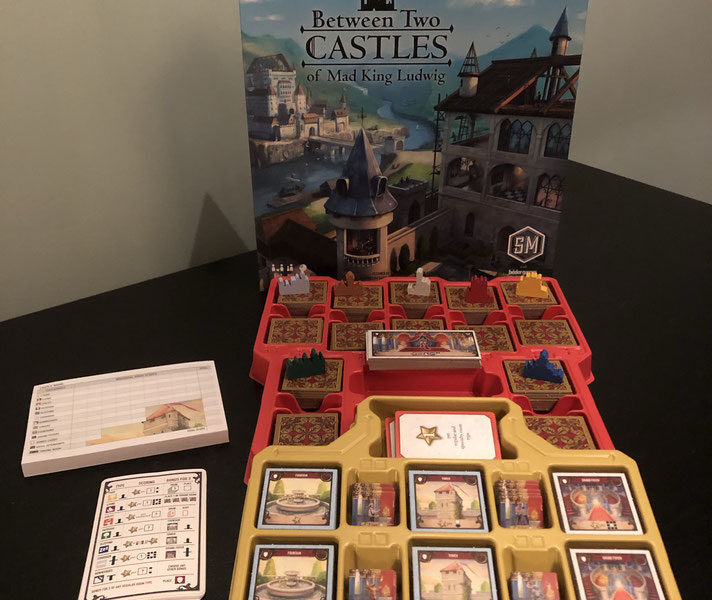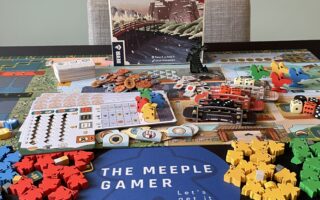
Game summary:
A game for 2 – 7 players
Play time 45 – 60 minutes
Designer: Matthew O’Malley, Ben Rosset
Artist: Laura Bevon, Agnieszka Dabrowiecka, Bartłomiej Kordowski, Noah Adelman
Publisher: Stonemaier Games
Here you see the large tray with the regular room tiles, throne rooms tiles and the castles. For the picture I’ve turned al the regular room tiles face-up but when you’re ready with the game, don’t do this at home. Every player has to take them face-down.
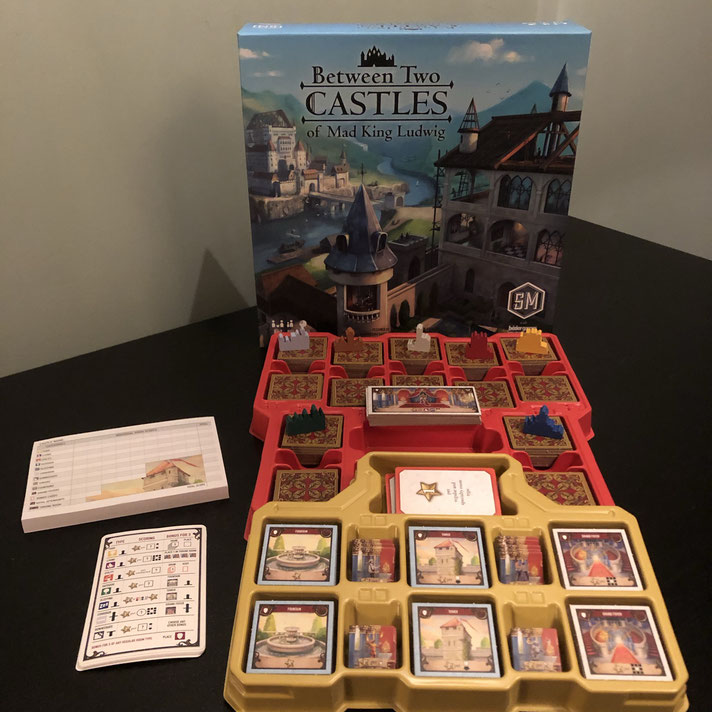
Unboxing
This game box contains the following components:
1 Rulebook
147 regular room tiles (21 of each type)
48 specialty room tiles
7 player aids
28 royal attendants
20 bonus cards
7 castle tokens
7 throne room tiles
Scoring sheets

Here you see the large tray with the regular room tiles, throne rooms tiles and the castles. For the picture I’ve turned al the regular room tiles face-up but when you’re ready with the game, don’t do this at home. Every player has to take them face-down.
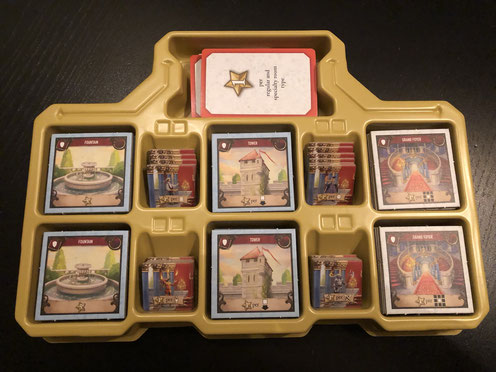
Here you see the small tray with the specialty room tiles, bonus cards and the royal attendants
Let’s get it to the table
The king demands a castle! You are a world-renowned master builder who has been asked by te Mad Kind Ludwig to help design his castles. Projects of such significance require the expertise of more than one person, so for each assignment you are paired wit another master builder to execute your grandiose plans. Will your planning and collaborative skills be enough to design the most impressive castles in the world?
Between Two Castle of Mad King Ludwig is a tile-drafting game in which each tile is a room in a castle. You work together with the player on your left to design one castle and with the player on your right on another castle. On each turn you select two tiles from your hand, reveal them, then work with our partners to place one of your selected tiles into each of your two castles.
At the end of the game, each castle is scored. Your personal final score is the lower of the scores of the two castles you helped design, and the player with the highest final score wins the game. To win, you have to share your attention and devotion between two castles.
The setup of Between Two Castles is really not a lot of work. In the game box you’ll find a small tray and a large tray, you can get these out of the game box and place them on the table. The small tray can be placed below the large one. The large tray contains 147 regular room tiles, the small tray contains 48 special room tiles, 20 bonus cards and 28 royal attendants. The special rooms may never be shuffled with the regular room tiles!
In the large tray you’ll find 7 throne rooms and place 1 of them between each pair of players, place also a wood castle below each of these rooms. The remaining castles and rooms can be placed in the game box.
Every player also receive a player aid.
Shuffle the bonus cards and place them as a face-down stack in the small tray.
Now we’re ready to play!
The game will be played in 2 rounds.
At the start of each round, you draw 9 tiles. On each turn, you choose 2 tiles to place face-down in front of you, and pass the rest of your hand to the next player. To finish your turn, you flip over 2 selected tiles face up and-after discussion with your partners-place 1 of them in each of your two castles.
The tiles that you select and their positioning in the castle define how many points you score at the end of the game.
Building your castles
Each castle is on side-view. You start with the throne room on the ground level of your castle. Your castle can be expanded up and out in all directions.
– Placing a tile above your throne room will start another floor of the castle and makes your castle taller, there’s no limit to the height of a castle
– Placing a tile next to your throne room, also on the same floor makes your castle wider, there’s no limit to the width of a castle.
– All tiles that you place above the ground level must be supported by a tile below. Tiles on the ground level or below ground must be adjacent to other tiles but they do not have other requirements.
– Food, living, utility, outdoor and sleeping rooms can only be placed at the ground level or above.
– Corridor rooms can be placed on any level of your castle.
As mentioned earlier, there are 2 rounds. Both rounds will follow almost the steps, in round 1 you place the remaining tiles face-down under the castle token on your left and in round 2 you place the remaining tiles face-down under the castle token on your right.
Steps in Round 1 and 2;
First everyone draw 9 tiles from the large tray and hold them secretly in their hand. Then you take the following actions in order;
1. Choose; you choose 2 tiles from your hand, don’t communicate with the other players. Place in round 1 the remaining tiles face-down under the castle token to your left;
Place in round 2 the remaining tiles face-down under the castle token to your right.
The reason why you place those tiles under the castle token is to give the other players a signal that you’re ready.
2. Reveal; When everyone has chosen their tiles, all players reveal their chosen tiles.
3. Place; Now you’re going to place one of tiles into the castle on the left and the other one into the castle on the right (or other way around). You may now discuss with your partners on both sides to determine the best location for your chosen tiles. You may also discuss with your partners during this step which tiles are in the stack you just passed to them.
The reason to discuss with your partners is a really cool and interesting part of the game. You want to have the best castle on both sides, because the castle with the lowest score is your castle for the final score.
During each turn, 2 tiles will e place into each castle, one from you and one from your partner. Both player can choose which tile can be placed earlier.
You repeat the actions 1, 2 and 3 until there is only 1 tile remaining under the castle on your left or right (in round 2).
Room bonuses and scoring;
You can receive some bonusses when placing tiles;
When you place your 3rd tile of the same regular room type anywhere in the castle, that castle immediately receives a specific bonus for that tile type. Discuss with your partner where you place that bonus.
When you place your 5th tile of the same regular room type anywhere in the castle, you can immediately choose any 1 specialty room tile and place in into your castle. On the player aid you can find the scoring and bonuses for each room type.
In Between Two Castle there are 7 different regular rooms, all of those rooms score at different ways;
Food Rooms; must be placed at the throne room level or above, each food room has 1 type of room that it want to be either directly above and below or directly to the eft and right of it. The food room receives 2 points for each room it want that’s in the correct position.
A food rooms can score a maximum of 4 points.
The bonus for this 3rd room is that you immediately draw 5 tiles for the supply of the face-down regular room tiles. Choose 1 of those tiles to place into your castle, discard the other 4 tiles. When in any case you place a 3rd or 5th tiles, you take the new bonus after placing this tile.
Living Rooms; must be placed at the throne room level or above, each living room has a particular type of room that it want to be surrounded by, it scores 1 or 2 points for each of that room type that has surrounds it.
The most living rooms can score a maximum of 8 points.
The bonus for this 3rd room is that you immediately choose to place a royal attendant into one of the two spots in your throne room.
Utility Rooms; must be placed at the throne room level or above, each utility room shows one room type that it wants to be connected to it. The utility room scores 1 point for each room of that type that is connected to it. A room is connected if you can trace a path back to the utility room using only that rom type.
There is no limit to the number of points a utility room can score.
The bonus for this 3rd room is that you immediately draw 3 bonus cards. You choose 1 of those cards to keep and place this card face-up beneath the castle.
Outdoor Rooms; must be placed at the throne room level or above, each outdoor room has a particular type of room that it wants in the castle. It scores 1 point for each room of that type present anywhere in the castle.
There is no limit to the number of points an outdoor room can score.
The bonus for this 3rd room is that you immediately place a fountain. Fountains are a special room type and can be placed at the throne room level or above, they always score 5 points.
Sleeping Rooms; must be placed at the throne room level or above, each sleeping room scores 4 points if your castle has all the 6 other regular room types by the end of the game. It doesn’t matter where they are placed. When you don’t have those 6 rooms, each sleeping room scores 1 point.
Each Sleeping Rooms can score a maximum of 4 points
The bonus for this 3rd room is that you immediately place a tower. Towers are a special room type and can be placed at the throne room level or above. They are worth 1 point for each room below them, including the rooms below the throne room level. There is no limit to the number of points a tower can score.
Corridor Rooms; can be placed anywhere in the castle, for scoring each corridor room has a particular wall hanging that it wants to be surrounded by, it scores 1 point for each wall hanging of that type surrounding it.
A corridor room can score a maximum of 8 points.
The bonus for this 3rd room is that you immediately place a Grand Foyer. The Grand Foyer can be placed anywhere in the castle, you score 1 point for each surrounding room. A Grand Foyer can score up to maximum of 8 points.
Downstairs Rooms; must be place below the Throne Room, for scoring each downstairs room wants a particular room type above it, and it scores 1 points for each of that room type anywhere in the same vertical column of the castle.
There is no maximum to the number of points a downstairs room can score.
The bonus for this 3rd room is that you immediately can choose any other room type bonus even if you already obtained it earlier or not.
You always start with the Throne Room, each throne room has 2 particular room types that it wants to be adjacent to, and 2 specific spots where it wants those room types to be. This room scores 2 points for each of the two spots.
Between Two Castles can also be played with 2 players. In this case there will be a 3rd player called Ludwig. Ludwig sits between both players and the setup will also be like 3 players. In round 1 the player on the left of Ludwig will draw tiles for this player, and in round 2 the player on the right of Ludwig will draw tiles for this player.
Ludwig always takes his 2 tiles and then the other player chooses their tiles.
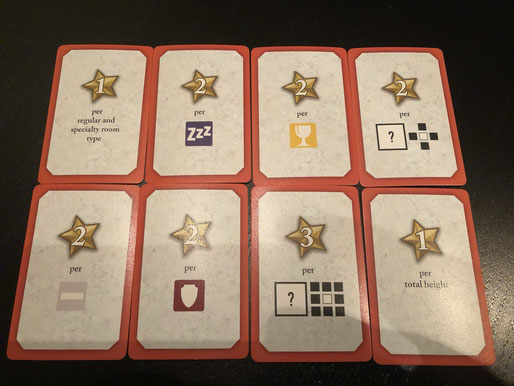
A few examples of the bonus cards, in the rulebook you can find an explantion of al the bonus cards.
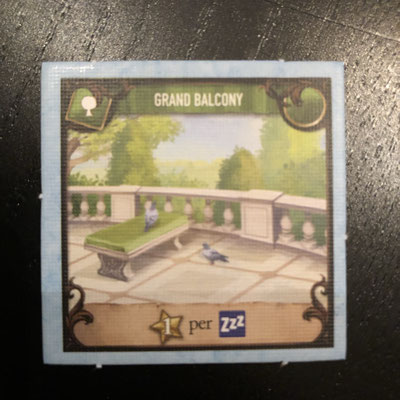
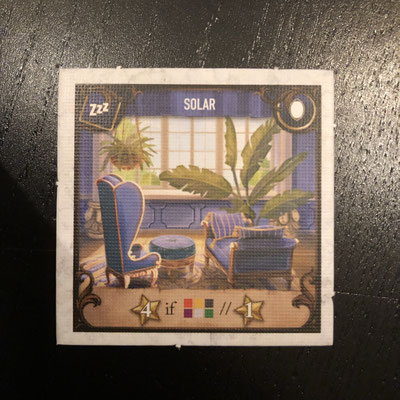
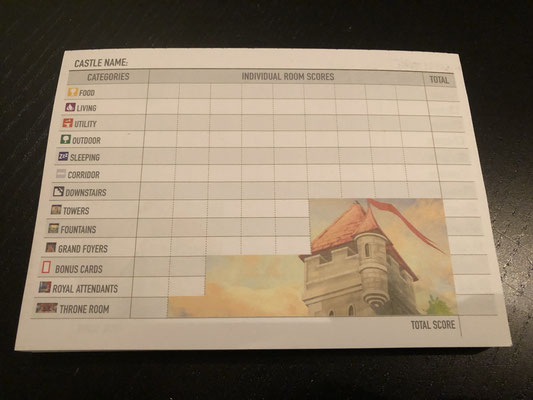
End of the game
After round two is over, each castle is scored. Each player now takes a score sheet and calculates the score for the castle to their left. Once this is complete, compare the scores for the castle to your left and the castle to your right.
Your personal final score is the lower of the scores of your 2 castles. The player with the highest final score wins.
In a 2 player variant; When playing with Ludwig, it’s also possible that both human players will lose and Ludwig wins!

An overview of the different tiles that you can get on the table! This isn’t an example of a Castle that’s been build!
Final Conclusion & rating:
Weight: 2 / 5
Replayability: 8
My rating: 🎲 🎲 🎲 🎲 🎲 🎲 🎲 🎲
Set up of the game
Setting up Between Two Castles is really easy, well if you don’t forget to organize is at the end of your game 😉. But when you’ve organized it, the game is really in about a couple of minutes (2or 3 minutes) ready to play. You get the 2 trays out of the box, give every player a Player Aid.
Then shuffle the 7 throne rooms tiles and place one between every player.
When playing with 2 players don’t forget player Ludwig! Below the throne rooms, you also place a castle token. This castle token is just to place the rooms tiles under it, they don’t have any special ability.
Shuffle the bonus cards and place these face-down in de small tray and after this is done, you’re ready to start the game.
Quality of the components
The components that belong to this game are again great! Especially the use of GameTrayz trays are very good, setting up the game is really a piece of cake. The tiles themselves feel solid and the artwork on these tiles is very nice and well done! It’s really nice to see so many different tiles and especially if you manage to make them visible in your castle.
The wooden castles all look different and that makes it fun to see. This gives you the idea that everyone is building a different castle, which you can of course see by the tiles and the shapes that everyone is building, but it makes it even more special.
Game rules are explained very well and clearly, for each room there is a special page where everything is explained for that room including examples. This makes it very easy to prepare the game but also to use it to explain it to other players.
The player aid is in my opinion actually an obligation to be added to every game, maybe a bit exaggerated, but I find it really useful!
Overall impression of the game
My overall impression of Between Two Castles of Mad King Ludwig, when I first started reading the rules, I really had to take a good look to see if I was reading it right. Do I now have to build a castle together with my neighbour and not on my own, so I have to consult each other all the time? Yes, that’s what it said, but isn’t that strange? Yes, actually, you would say so, but in this case it makes it a lot of fun to build a castle together and to ensure that the castle scores enough points and to make nice/strong combinations of the various rooms. But you also have to make sure that it’s not the castle with the most points, because then you won’t get the corresponding points. Sorry, you don’t get the points of the castle with the most points but the one with the least points? Correct! This is really quite different from anything I’ve ever played before, but what makes it fun is that this also applies to your neighbour. The neighbour on the other side doesn’t automatically get the castle on your left or right, but the one with the fewest points.
As you can see it’s a completely different game, can you describe it as a cooperative game? Yes and no, you play together but also against each other, but ultimately you want to score as many points as possible for both castles, so yes you consult with each other but also watch carefully to ensure that the scores of your castles are a bit equal to up. So you work with each other but also against each other.
When the game first came out and I saw it on Spiel, I was disappointed. Especially the price in combination with what was in the box, it was not a game that immediately attracted me. But after I really sat down and played the game several times, unfortunately not a 2-player game, it really surprised me. The game does not come close to my other games by Stonemaier, especially Scythe and Viticulture are really my favourites, but it is a very fun game. The game is therefore more suitable for the novice players, but also the experienced players can certainly get their satisfaction from it. Especially because you can make so many combinations with the rooms to get your score even higher and use the special rooms. My final verdict is that Between Two Castles of Mad King Ludwig is a very nice game that will certainly be on my table!
I want to thank Stonemaier Games for giving me the possibility to review Between Two Castles of Mad King Ludwig.
